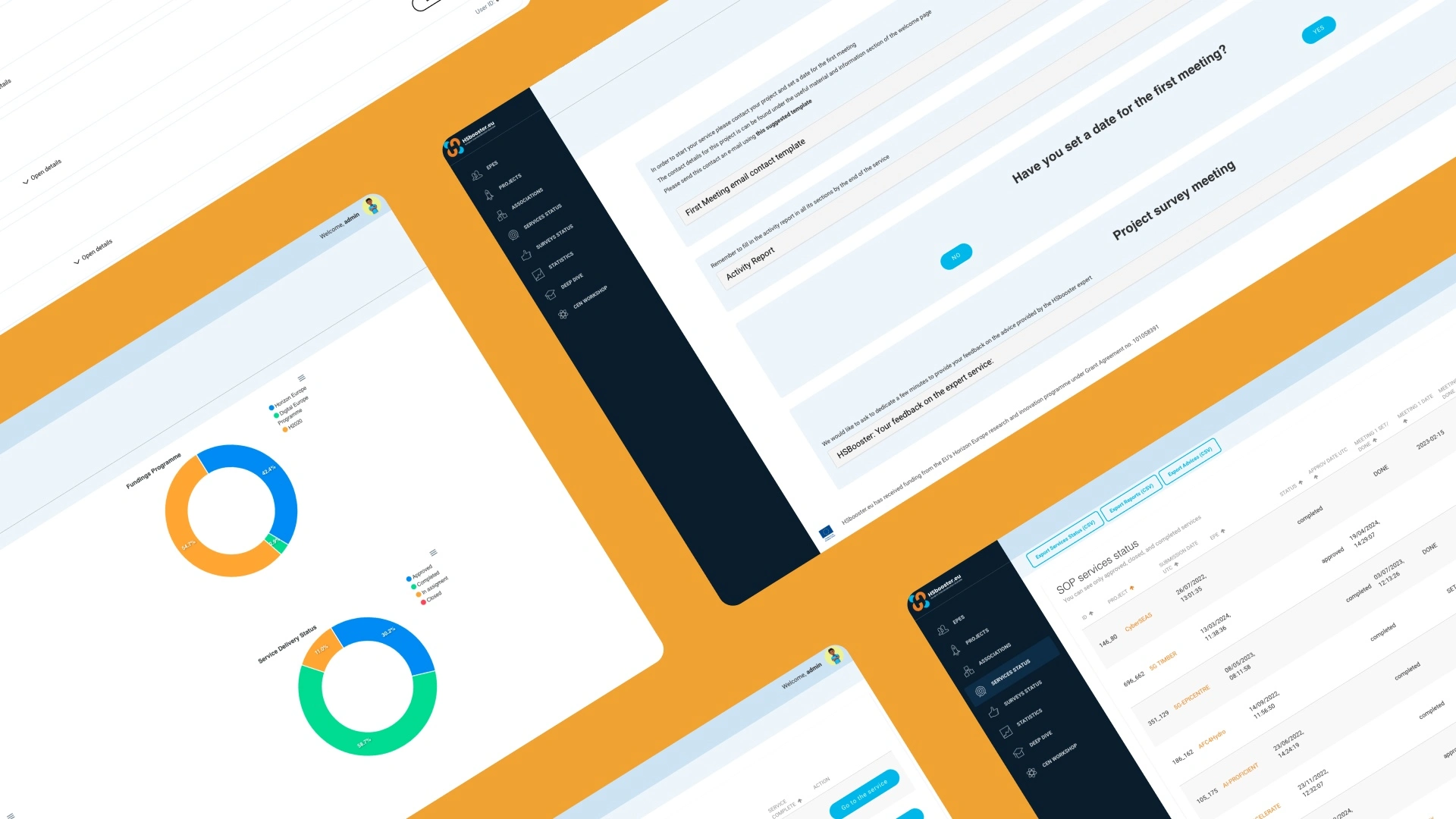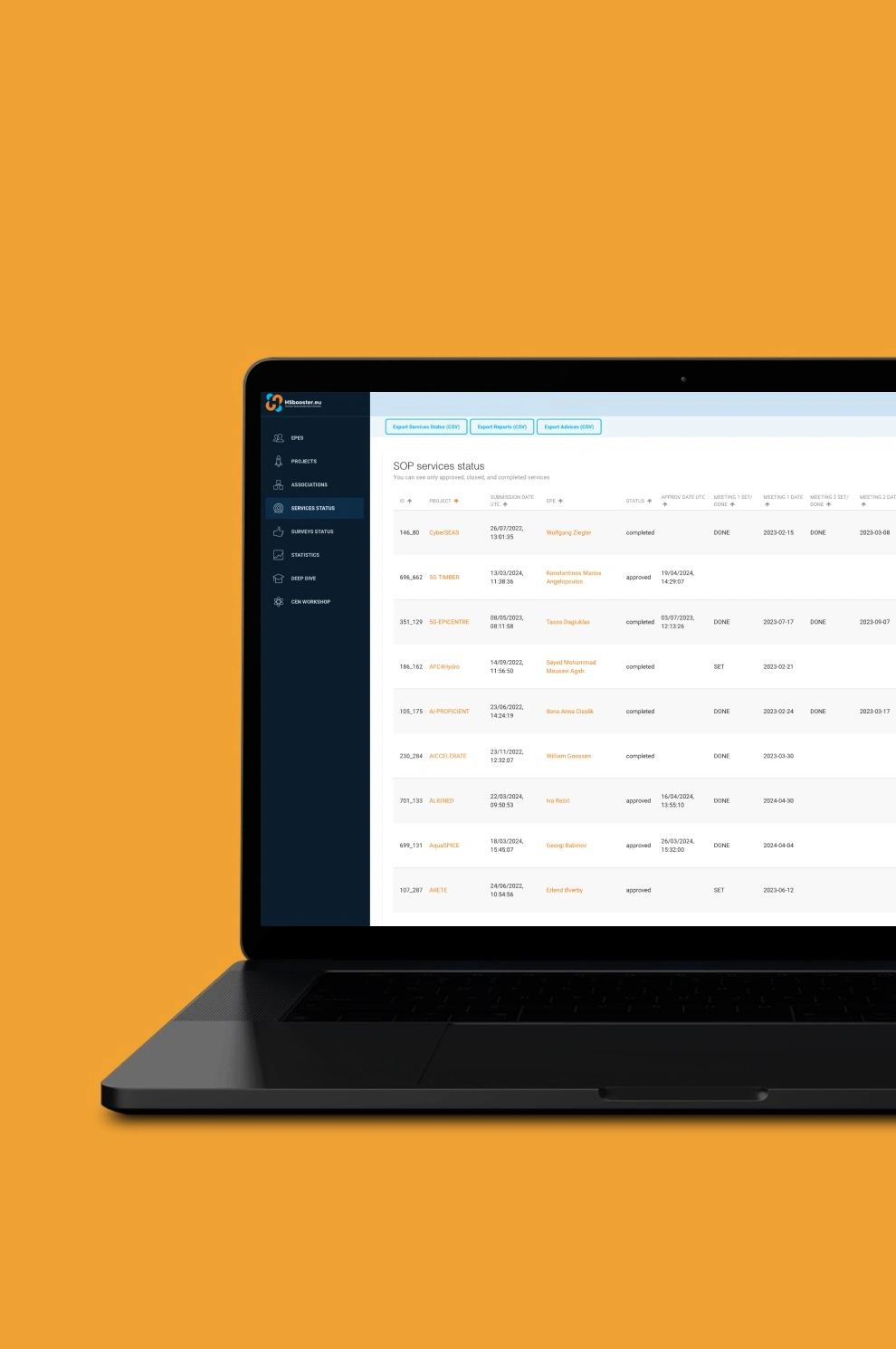Standard Operating Procedure & Standards Orientation Tool
Scroll down

The Project challenge
Within the framework of the HSBooster project, at COMMpla we have played a pivotal role in the successful implementation of two vital services: the Standard Operating Procedure (SOP) and the Standards Orientation Tool (SOT). These tools are essential for guiding stakeholders through the complex landscape of standards and procedures, ensuring that project goals are achieved efficiently and effectively. Thanks to our expertise and innovative approach, we have made a significant contribution to the project’s mission of enhancing standardisation practices and fostering collaboration across the industry.
The Standard Operating Procedure (SOP) encompasses the HSBooster.eu premium service, where an Expert Project Evaluator (EPE) provides guidance and advice. This premium service is the flagship offering of HSBooster.eu. The bespoke service is driven by the efforts of a dedicated expert (EPE) who is specifically matched to a project within their area of expertise.
The role of the HSBooster.eu consortium in the Premium Service level includes:
- Acting as a facilitator to match experts with eligible projects;
- Developing criteria and assigning relevant experts to selected projects, with dedicated templates for the experts to use;
- Creating an evaluation module and feedback system for applicants to monitor outcomes;
- Facilitating the budget for projects to enrol in SDOs, WGs, and to purchase copyrighted material (e.g. standards, specifications);
- Liaising with Expert Project Evaluators (EPEs) for educational purposes in defining their roles and responsibilities.
The Standards Orientation Tool (SOT) aims to serve as a comprehensive tool for standardisation strategy. The main objectives it seeks to achieve are:
- Analysing existing standards and ongoing standardisation work;
- Conducting a standards gap analysis;
- Deciding on a standardisation strategy;
- Contributing to standardisation activities;
- Promoting standardisation results.
The Standardisation Readiness Level (SRL) is based on the Technology Readiness Level (TRL) method developed by NASA for space technology development. This methodology has been adapted for general use to describe the maturity of a research area in relation to its scalability and market potential/readiness.
Development Process
The implementation of the two tools, SOP (Standard Operating Procedure) and SOT (Standards Orientation Tool), within the HSBooster project followed a series of structured steps designed to ensure that both tools effectively met the project’s needs and those of its users.
- Requirements Gathering
The first step involved requirements gathering, a crucial phase for defining the specific needs of the project. During this stage, various stakeholders were engaged to identify the necessary features and functionalities. The goal was to provide tools that would support users in achieving the specific objectives of the project. - Specification Definition
Following the initial requirements gathering, the next phase focused on defining the specifications. Within the consortium, detailed discussions took place to outline the steps and user flows for different types of users interacting with the SOP. For the SOT, the focus was on determining the contents of the questionnaire and the flow for generating tailored advice. This phase was essential to ensure that each tool was tailored to address the specific challenges and opportunities identified during the requirements gathering. - Development Phase
With the specifications clearly defined, the project moved into the development phase. For the SOP, this involved fine-tuning the matching algorithms to ensure that the EPEs were effectively paired with the projects that applied for support, thus facilitating a seamless association process within the consortium. - Ongoing Integration and Enhancement
Throughout the software’s lifecycle, it became necessary to integrate, modify, and expand functionalities to accommodate emerging needs and scenarios. This iterative process ensured that the tools remained robust and adaptable, capable of covering a wide range of cases and continuing to provide effective support to the project’s objectives.
Each of these steps was critical in the successful implementation of the SOP and SOT, ensuring that they were both user-centric and aligned with the overarching goals of the HSBooster project.


Features and Functionality of the SOP
The Standard Operating Procedure (SOP) within the HSBooster project is a sophisticated tool designed to facilitate the pre-matching process between EPEs and projects seeking support. This functionality is crucial in ensuring that the most suitable experts are paired with the appropriate projects, thus maximising the impact of the consultancy provided.
Pre-Matching and Criteria Definition
The pre-matching process in SOP is guided by criteria that have been carefully defined based on specific fields provided during the project application phase and the proposal phase from the experts. These criteria ensure that there is a strong alignment between the needs of the projects and the expertise of the EPEs. When there is an equal level of matching between the project’s requirements and the expert’s qualifications, the EPEs are then subject to a ranking system that is determined through a hybrid approach.
Hybrid Ranking System
The ranking system in SOP involves two components:
- Automatic Scoring: A portion of the ranking is calculated automatically by an algorithm that has been fine-tuned to assess the declared expertise of the EPEs.
- Manual Validation: The remaining portion of the ranking is manually validated within the consortium, allowing for a comprehensive evaluation that considers both quantitative and qualitative factors.
This dual approach ensures that the final matching is not only technically accurate but also validated by expert judgement within the consortium.
Structuring the Consultancy Service
Once the association between an EPE and a project is confirmed, the SOP allows the EPE to structure the consultancy service according to a standardised procedure, which includes up to four meetings. During these meetings, the expert provides consultancy services to the project and documents the process and outcomes in a dedicated report through the platform. This structured approach ensures consistency and quality across the consultancy services provided within the project.
Reporting and Analytics
The SOP also offers robust reporting and analytics capabilities, enabling the consortium to collect and analyse all relevant data. This includes generating reports, dashboards, and visual graphs to identify key topics addressed and to analyse the composition of the associations based on various parameters, such as gender balance, nationality balance, and more. This feature is instrumental in maintaining transparency and ensuring that the project meets its diversity and inclusion goals.
Features and Functionality of the SOT
The Standards Orientation Tool (SOT) is a more straightforward yet highly effective tool that enables users to complete a self-assessment questionnaire. The SOT is designed to enhance user awareness and provide tailored advice based on the responses given.
Questionnaire Completion
The SOT allows users to fill in the questionnaire either anonymously or as registered users. If a registered user completes the questionnaire, certain fields are automatically populated, thus reducing the time required to fill out the questionnaire. This functionality streamlines the user experience, making the process more efficient.
Advice Generation
Based on a predefined flow, which is statically specified, the SOT analyses the user’s responses and generates a series of tailored advice aimed at improving the user’s awareness and understanding of the standardisation processes relevant to their needs. This advice is specifically designed to help users fine-tune their approach to standardisation, providing actionable insights that are directly relevant to their situation.
The simplicity of the SOT, combined with its targeted advice, makes it an invaluable tool for users looking to navigate the complex landscape of standards with greater confidence and precision.
Technologies and Tools
The development of both SOP and SOT involved the use of modern design and development tools:
- Integration with the project Drupal website for the account creation, authentication and authorization;
- Angular framework for the frontend development;
- Django framework for the backend development.
Are you looking for experienced designers & developers who can build the custom software you need if you’re working with standards?
Fill out the form below and let’s have a chat!